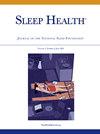“No rest for me tonight”: A social-ecological exploration of insomnia in rural Appalachian women
IF 3.4
2区 医学
Q2 CLINICAL NEUROLOGY
引用次数: 0
Abstract
Objectives
Insomnia disproportionally affects women and is prevalent among rural Appalachian adults at higher rates than in the general US population. Given the strong, bi-directional relationship between sleep and health, a better understanding of insomnia in this health-disparate population is critical. The present study focused on the sex (females), gender (women), and age group (45+) at highest insomnia risk and explores the social determinants of sleep that contributed to insomnia.
Methods
Semistructured telephone interviews were conducted to understand factors associated with insomnia among rural Appalachian women who self-reported insomnia symptoms ≥3 nights per week for ≥3 months. Interviews were recorded with permission and transcribed. We used a multistage, inductive and deductive coding process aided by NVIVO 12.0 software.
Results
Participants were 46 cisgender women in rural Appalachia who met the criteria for insomnia. The social-ecological model was our interpretative framework. Findings illuminate individual (e.g., rumination, menopause, pain, depression), social (e.g., family roles, grief, caregiving, financial concerns), and societal (e.g., gender norms, technology use) factors that likely contribute to insomnia among middle-aged rural Appalachian women.
Conclusions
Across levels of the social-ecological model, factors of female sex (e.g., menopause) and gendered behaviors, roles, and norms (e.g., caregiving close and extended kin) played a central role in the precipitation and perpetuation of insomnia in this population. Attending to the regional cultural norms of heightened self-sufficiency, domestic work, and inter-generational familial care may aid healthcare providers and policy makers aiming to address insomnia among rural Appalachian women as well as other rural populations.
“今晚我不休息”:阿巴拉契亚农村妇女失眠的社会生态学探索。
目的:失眠症对女性的影响不成比例,在阿巴拉契亚农村成年人中普遍存在,其发病率高于美国总人口。考虑到睡眠和健康之间强烈的双向关系,更好地了解这些健康状况不同的人群的失眠是至关重要的。目前的研究集中在失眠风险最高的性别(女性)、性别(女性)和年龄组(45岁以上),并探讨了导致失眠的睡眠的社会决定因素。方法:采用半结构化电话访谈法,对自述失眠症状≥每周3晚、持续≥3个月的阿巴拉契亚农村妇女进行调查,了解与失眠相关的因素。采访是在获得许可的情况下录制并抄写的。在NVIVO 12.0软件的辅助下,我们采用了多阶段的归纳和演绎编码过程。结果:参与者为46名阿巴拉契亚农村符合失眠标准的顺性别妇女。社会生态模型是我们的解释框架。研究结果阐明了可能导致阿巴拉契亚中年农村妇女失眠的个人因素(如沉思、更年期、疼痛、抑郁)、社会因素(如家庭角色、悲伤、照顾、经济问题)和社会因素(如性别规范、技术使用)。结论:在社会生态模型的各个层面上,女性性别因素(如更年期)和性别行为、角色和规范(如照顾近亲和远亲)在该人群中失眠的形成和延续中发挥了核心作用。关注提高自给自足、家务劳动和代际家庭护理的地区文化规范,可能有助于医疗保健提供者和政策制定者解决阿巴拉契亚农村妇女以及其他农村人口的失眠问题。
本文章由计算机程序翻译,如有差异,请以英文原文为准。
求助全文
约1分钟内获得全文
求助全文
来源期刊

Sleep Health
CLINICAL NEUROLOGY-
CiteScore
6.30
自引率
9.80%
发文量
114
审稿时长
54 days
期刊介绍:
Sleep Health Journal of the National Sleep Foundation is a multidisciplinary journal that explores sleep''s role in population health and elucidates the social science perspective on sleep and health. Aligned with the National Sleep Foundation''s global authoritative, evidence-based voice for sleep health, the journal serves as the foremost publication for manuscripts that advance the sleep health of all members of society.The scope of the journal extends across diverse sleep-related fields, including anthropology, education, health services research, human development, international health, law, mental health, nursing, nutrition, psychology, public health, public policy, fatigue management, transportation, social work, and sociology. The journal welcomes original research articles, review articles, brief reports, special articles, letters to the editor, editorials, and commentaries.
 求助内容:
求助内容: 应助结果提醒方式:
应助结果提醒方式:


